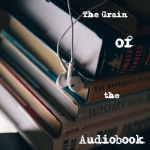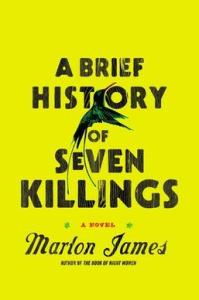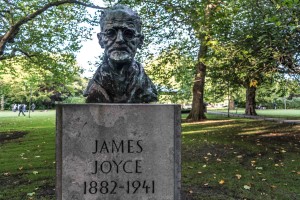“Recorder of Dublin”: Ulysses’ FX in 1982

 For many, the audiobook is a source of pleasure and distraction, a way to get through the To Read Pile while washing dishes or commuting. Audiobooks have a stealthy way of rendering invisible the labor of creating this aural experience: the writer, the narrator, the producer, the technology…here at Sounding Out! we want to render that labor visible and, moreover, think of the sound as a focus of analysis in itself.
For many, the audiobook is a source of pleasure and distraction, a way to get through the To Read Pile while washing dishes or commuting. Audiobooks have a stealthy way of rendering invisible the labor of creating this aural experience: the writer, the narrator, the producer, the technology…here at Sounding Out! we want to render that labor visible and, moreover, think of the sound as a focus of analysis in itself.
Over the next few weeks, we will host several authors who will make all of us think differently about the audiobook selections on our phone, in our car, and in our radios. Today we start things off with a close listen of the 1982 audiobook edition of James Joyce’s Ulysses. Watch out for the hoooooooooooooonk of the SO! train pulling into the station!
—Managing Editor Liana Silva
To think about James Joyce’s Ulysses is to think about the first instant when it truly seized your ears. Accordingly, my Ulysses begins in its final episode, “Penelope”: Molly Bloom is lying down or sitting up next to a passed-out Leopold Bloom when she hears the “frseeeeeeeefronnnng train somewhere whistling.” Her train does not go chug, choo, or chuff, but it rhymes with her “Loves old sweeeetsonnnng” (1669) with an infectious insouciance for the codes of language. Let us call this the Ulysses of 1922 (though the definitive edition of James Joyce’s book whose page numbers are cited here was produced in 1984 by Hans Walter Gabler).
The Ulysses of 1922 is what Jacques Derrida called gramophonic. It plays back to us something recorded without filtering out the noise and is to be heard more than it is to be read. We listen to the book, but we are second-in-line. The first listener is the book itself, which listens to Dublin and records everything with an odd sonic democracy, discriminating little amid its recording of all sounds vivid or vapid, giving equal importance to cats, carts, bells, machines, laughter, coughs, and language. The book saunters about the city, listening and recording, and we listen to the book like we would to a scratchy, static-filled recording of a concert the morning-after. It is a reminder of something Michel Serres once said in The Five Senses: “Meaning trails this long comet tail behind it. A certain kind of æsthetics… take as their object this brilliant trail” (120). Ulysses’ elusive modern city glows in this comet tail of noise and background static more than it pivots around conventionally meaningful language content. Eventually, industrial and technological modernity catches up with artistic modernism and in 1924, Joyce reads and records parts of the “Aeolus” episode of Ulysses, and later in 1929 he records a section of Finnegans Wake. Many years after, in 1982 – the centenary year of Joyce’s birth – Ulysses comes home to Dublin and is recorded in full by Irish national radio.
The 1982 Ulysses Broadcast was an uninterrupted twenty-nine-and-a-half-hour reading of the entire unabridged text on Ireland’s RTÉ Radio on 16th June – Bloomsday – produced by Micheál Ó hAodha. Among this and the two film versions, one from 1967 and the other from 2003, and other recordings such as the ones by LibriVox volunteers and a more recent one by BBC Radio 4, the 1982 Ulysses Broadcast was the first complete recording of the text. Director William Styles called upon voice actors from the Radio Éireann Players to dramatize and act Ulysses out.
My Ulysses of 1982 seizes me differently from the book. From the first seconds of the 1982 Broadcast, I reacted to Buck Mulligan stepping down the stairs inside the Martello Tower with surprise, because the reading is somewhat copiously accompanied; the sounds of loud waves outside of the walls of the seaside tower were part of the soundscape I was thrown into:
Immersion was of the essence. Not that the Ulysses of 1922 is by any means a silent text, but this accompaniment was a simultaneous roar. Sounds in the written text take up space, and as these sounds are being “played” in the book, there is a length of text where nothing else is happening. Think, for instance, of the machinery in the “Aeolus” episode: “Almost human the way it sllt to call attention” (251). As the “sllt” is recorded by the book, it is not over or behind any other sound or voice. It takes up its own space, unlike in the Broadcast
The layering of Buck Mulligan’s voice over the sounds of the sea becomes possible in the move from the spatial-visual of the page to the temporal-aural of a recording. However, listening to the Broadcast prompts me to ask: Is the sonic democracy of recording the soundscape still there?
Most critical work on the audiobook focuses on readerly reception and pleasure, almost indicating that we can hear the Ulysses of 1922 but we must read the Broadcast of 1982; the book provides for more direct sensory engagement while with the Broadcast, we must focus on analyzing the mechanics of our reception. We also get terms like Reinhart Meyer-Kalkus’ “hear-reading” (179) or Matthew Rubery’s “ear contact” (72) which are concerned with the link between the playback of the recorded text and the reading ear. We hear-read when we listen to the voice in our heads recite aloud to us what we are reading, and we establish ear contact, much like eye contact, when we find our ears bound to voices instead of people. Both these concepts are concerned with reception. If we steer clear of our listening of the Broadcast and turn the focus to the Broadcast’s listening of Ulysses, what we find is a rich sonic world, but it is one which takes us away from the linguistic play of the text.
For instance, the book gives cues for the ambient sounds of Dublin clamor surrounding any voice which might be speaking at that moment. “Stream of life” (327) signals in the Broadcast the coming alive of the city soundscape. What is described as a “sudden screech of laughter” (255) in the book is layered upon loud laughter in the Broadcast, as is “a loud cough” (281) upon a loud cough, and a telephone which “whirred” (283) upon the sound of an actual ringing telephone. Later, in the “Circe” episode, a mention of whistling (1169) is also whistled out.
Trams, the clatter of plates and glasses, desks being rapped, coins and bells ringing and jingling, cannon-firing, all these sounds are played as accompaniments again and again as their descriptions are being voiced in the Broadcast. Like in bedtime storytelling, says Brigette Ouvry-Vial, sound effects as uncomplicated accompaniments are never in conflict with the voiced text. Think of pictures and illustrations alongside words in children’s literature (185). The background sound effects of the broadcast add nothing to the sonic democracy of the book even if they do not detract from it.
The Ulysses of 1922 is also rife with non-lexical, unpronounceable sounds, like the one’s Bloom’s cat makes. The many different cat sounds, for example “Mkgnao!” and “Mrkgnao!” and “Mrkrgnao!” (107-8), are not voiced at all in the broadcast, and are instead replaced by the mimicked sounds of a cat meowing, almost exactly the same each time:
“Miaow!” (133) and “Prr” (107), which are Bloom’s responses to his cat, are voiced by him. When the “door of Ruttledge’s office whispered: ee: cree” (243), there is no voicing – only the sound of a creaking door. Yet, when we are in Bloom’s thoughts, like when he remembers a glorious gust of wind which blew up Molly’s skirt, he voices the gust of wind in the Broadcast going “Brrfoo!” (329), pronouncing the non-lexical word with a close-approximation. Would not the non-lexical sounds in his head suggest that he is thinking in sound rather than in language, much like many of us who can hear sounds in our heads? Often but not always, environmental sounds are retained as actual sounds while the sounds in Bloom’s head are sublimated into pronounceable, phonetic language. But mostly there is an insistence on adding sound effects wherever possible.
Whether the book describes the sound or sounds it with a non-lexical string of words, the Broadcast attaches its effects. If we look at the book as a recorder, its movements are staggeringly complex as it moves in and out of multiple spaces. When it is in Bloom’s head, the environment is muted, and when it is inside a carriage, unless it is poked out an open window, it does not record the street. Ssave for a few instances, the Broadcast’s insistence on effects attests to its rich production, but not to its vitality. It therefore stands as an accompaniment to the book, not as a text in its own right given its compositional inconsistencies. So, the several variations on Bloom’s flatulence with “Rrrrrr” (625), “Fff. Oo. Rrpr,” and “Pprrpffrrppfff” are all erased and instead fart sounds are recorded.
On the same page, when Bloom tries to mask his own sounds of bodily release under the din of the passing tram, the “Krandlkrakran” (629) is both voiced by Bloom and recorded as the sound of a noisily ringing tram in the background. But only an actual train whistles in “Penelope,” with no voice in the Broadcast attempting to say “frseeeeeeeefronnnng” (1669).
For Charles Bernstein, the sound of a work of literature, much like the shape of poetry on the page, might be an element which is “extralexical but… not extrasemantic” (5). It is different from the written word but it is not a meaningless ornament. For the Broadcast, however, it might as well be the case that sound is made irrelevant to meaning. Or, we can argue that the meaning being made is in the realm of performance studies and not literature. The pure temporality of the Broadcast helps. We can stop reading the book to look, but we cannot stop the Broadcast and still listen. Moreover, when the Broadcast records, it is listening to the book’s listening of Dublin, removed by another degree from the soundscape of Dublin.
The Broadcast is not however without value. Bernstein echoes Serres when he aggrandizes the “sheer noise of language” (22) which must take precedence over the impulse to decode everything. The Broadcast answers this need to not immediately rationalize and sublimate in analysis everything that is heard, but to rather hear without listening. Cue the poet Robert Carleton Brown who once said that writing since the very beginning has been “bottled up” inside of books (23). And in 1982, the stopper on Joyce’s spuming prose was popped.
—
Featured Image: “telemachus: the tower, 8 a.m., theology, white/gold, heir, narrative (young)” by Flickr user brad lindert, CC-BY-2.0
—
Shantam Goyal studies English Literature at the State University of New York at Buffalo for his PhD. He completed his M.Phil in 2018 from the University of Delhi with a dissertation titled “Listen Ulysses: Joyce and Sound.” He hopes to continue this thread for his doctoral research on Finnegans Wake and mishearing. Besides Joyce Studies and Sound Studies, he works on Poetics and Jazz Studies, and is also attempting to translate parts of Ulysses into Hindi as a personal project. His reviews, articles, and creative work have appeared in The Print, The Hindu Business Line, Vayavya, ColdNoon, Daath Voyage, and Café Dissensus among other publications. He prefers that any appellations for him such as academic, poet, or person be prefaced with “Delhi-based.”
—
 REWIND! . . .If you liked this post, you may also dig:
REWIND! . . .If you liked this post, you may also dig:
This Is How You Listen: Reading Critically Junot Diaz’s Audiobook-Liana Silva
“‘HOW YOU SOUND??’: The Poet’s Voice, Aura, and the Challenge of Listening to Poetry”-John Hyland
“This Is Not A Sound”: The Treachery Of Sound in Comic Books-Osvaldo Oyola

























Recent Comments